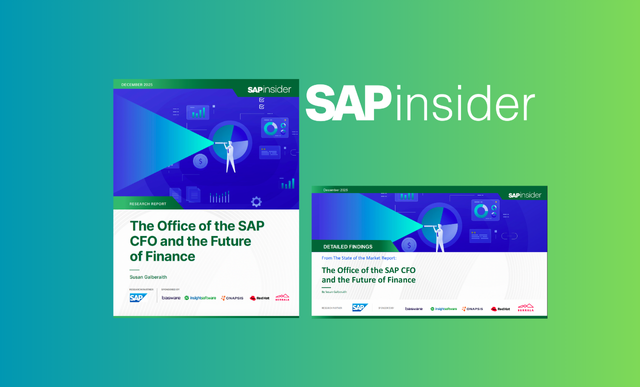S/4HANA Lessons Spawn New Business For Jabil
Meet the Authors
Key Takeaways
SAP S/4HANA proved to be a game changer for Jabil, a global manufacturing company
Jabil’s experience forged path to its own advisory to help other SAP customers considering S/4HANA migration
Jabil leveraged new technology through S/4 with Tricentis and Signavio which allowed it to make better decisions
Four years ago, with its on premise hardware in its data center getting ready to age out, global manufacturing company Jabil was faced with a decision. It could make a large capital to refresh its hardware or make the jump to the cloud.
Its decision to select SAP S/4HANA private cloud proved to be a game changer for Jabil – not only for driving innovation but also laying the foundation for a successful new business.
Back in 2019, Jabil faced its own challenges when seeking to migrate its SAP environments to the cloud. Most significantly, SAP’s RISE program was not yet an option for organizations like Jabil.
Explore related questions
“When we first started our journey, RISE really wasn’t in place for somebody of our size and complexity,” explains Cynthia Kendall, the company’s director of IT and head of advisory services.
With that in mind, the company made the decision to go it alone in migrating its large SAP environment to SAP S/4HANA Cloud on AWS.
Translating experience into advice
Through trial and error, Kendall and her team learned many lessons as they navigated their own path to the cloud, and the technology director has translated these experiences into advice for others undertaking their own SAP migration.
For example, one of the best pieces of advice that she can offer to companies in the same boat is to focus on laying the groundwork – well in advance of going live.
“There’s a lot of work that can be done, even today when customers don’t have their S/4 project funded or approved, but their team is there. There are things that their team can be working on in preparation – because it’s going to happen, whether they do it next year, the following year or they wait till 2027 [end of life for ECC 6.0]. There are a lot of activities that can be taken care of in the ECC environment to minimize that change management when they go live with their project.”
For instance, with the introduction of SAP S/4HANA, many transaction codes [t-codes] became obsolete, and older ECC systems must adjust to the new codes. Kendall’s team wanted to minimize disruption and go-live change management by removing a series of t-codes a year ahead of time.
“I don’t even think those users probably even recognized that they lost their favorite t-codes because of S/4. They just know they lost them, and then they’re given new t-codes to work with. So when we went live there was no transition for those users; they just kept moving on,” she tells SAPinsider.
Another valuable piece of advice? Despite a HANA application having “a Ferrari engine,” it still needs to be tuned and tweaked to produce its best performance.
“I finally realized even a race car doesn’t come off the trailer and race,” she says. “They do practice laps and tuning and changing and modifications for that particular track so that it runs at its optimum performance. You really need to do that with your HANA boxes, too.”
Because of this, Kendall admits that Jabil could have used a HANA database expert on staff. “The user’s expectation is that it’s a fine-tuned engine as well. So if there was any slowness felt or [if they] assumed it was not working as fast as what was expected, they were really ready to complain.
“Looking back, I should have known that kind of thing. I guess I bought into the ‘it’s this great engine and it’s going to run fast,’ and it does. But you also need to do some things to it.”
Becoming an advisor to other organizations
Moreover, Jabil’s experiences in forging its own path to S/4HANA private cloud have led to what is perhaps an industry first, in that it has developed its own advisory to help other SAP customers considering S/4HANA migration.
“Some of our customers and suppliers that utilize SAP were coming to us saying, ‘Okay, you were successful, and you didn’t miss a shipment…so we know that you guys handled it successfully on your side. How did you do that?’ Because there are customers out there that are going to S/4 that are failing,” explains Kendall.
“As I went to conferences, I was getting more and more people asking, ‘Hey, how can you share with us how you were successful?’”
Kendall realized there was an opportunity for Jabil to tap into a new source of revenue – sharing its knowledge, expertise and experience to help others navigate successful cloud migrations too. From there, Jabil’s Advisory Services Group was born.
The Group offers customized workshops to clients to help them understand “the art of the possible” with SAP. Kendall describes the role of the Group as an “independent observer to the project, to make sure that things aren’t missed and taking our lessons learned and ensuring that those projects are also following up with those lessons”.
She explains: “With the advisory services, [we’re] really able to tell customers what they can do now, before they even get their project funded. And what to do after they got the project funded. Because a lot of times, you’re like, ‘I’ve been fighting for this project to be funded for years and now [that] I got funded, what do I do?’ That’s where we can really come in and be a practitioner to a practitioner.
“We’re not competing against implementation partners. We’re not asking for access to the systems or anything like that. I’m there to give advice and direction from one person to another person because those customers I talked to are just like us.
“Implementation partners can come in and do their work and then they leave, but somebody still has to be able to make it work and run after the fact. We can help give that information and direction and advice for that too.”
Adopting a clean core strategy
Post-migration in its own organization, Kendall says SAP S/4HANA’s benefits are clear. One of the most obvious is the ability to flex up and flex down environments quickly as needed.
“It’s a lot easier to spin up environments and servers and spin them down after you’ve tested,” explains Kendall. “It’s a lot different when you’re in a cloud environment versus when you’re on premise where you’re having to order the server, wait for it to come, get it configured, get it hooked up, get it online.
“We’re talking weeks to months potentially – especially with what’s going on in the supply chain – versus hours to a day within the cloud.”
In terms of non-core ERP products, Jabil has been able to leverage new technology and functionality through S/4 with Tricentis and Signavio, which Kendall says allows the firm’s business teams to make better decisions. Jabil is also embracing SAP’s Business Technology Platform and pursuing a “clean core” strategy.
However, Kendall notes you don’t want “too many spinning plates and moving parts” during migration. “If you’re trying to do clean core at the same time as the migration, you can cause some problems to yourself. So we’re doing that post go-live.”
After analysis, Kendall’s team determined Jabil had 5 million lines of custom code, of which 3.5 million lines hadn’t been used in a 24-month period.
“We were able to deprecate that out and remove it, reducing our TCO and going ‘cleaner’ core, which really helped. I say clean core maybe in a different way than what SAP is intending – but it was still reducing all of our maintenance and is going to make an upgrade easier because we are not having to run through that code as well.”
Looking to the future with S/4HANA
Looking ahead to the rest of 2024, Jabil has both healthcare and medical instances running on Suite on HANA (SOH) and on Sybase. The company is now reviewing their options as to a move to S/4HANA.
And with the commercial instance that Jabil already moved on to S/4HANA 1909, Kendall’s team has started in sandbox, looking at an upgrade to 2023. “We’re continuing to keep things refreshed and upgraded,” she says.
“We have a shared services box that we’ve spun up that maintains payroll, has a master data governance in it, so we’re looking at combining that with GTS as well. We’re trying to make an umbrella environment to go over our main medical, healthcare and commercial instances to reduce the number of interfaces. It does all the connections instead of each system having the spaghetti code of connectivity going on.”
Unsurprisingly, Kendall describes the choice to migrate to S/4HANA private cloud as “the best decision”.
“We’ve seen the speed coming now from both a cloud and an S/4HANA environment. Our backflushes [used for automatic goods issue during order/operation confirmation] – which took a couple of hours, now it’s taking minutes to do. We have that Ferrari engine actually running around now.”








